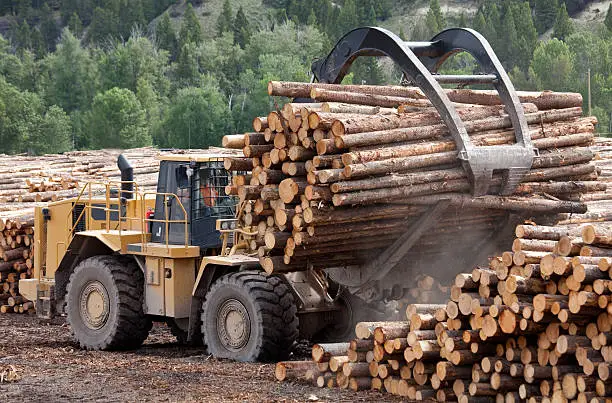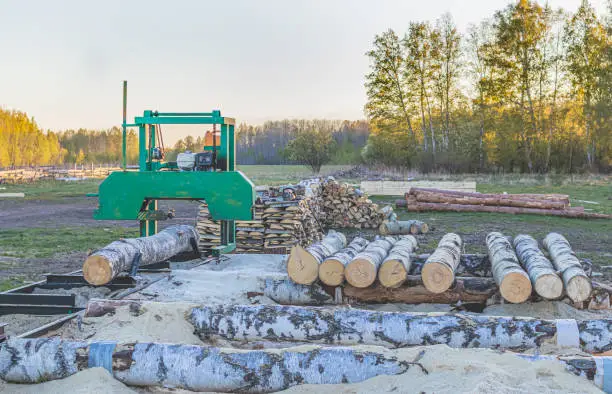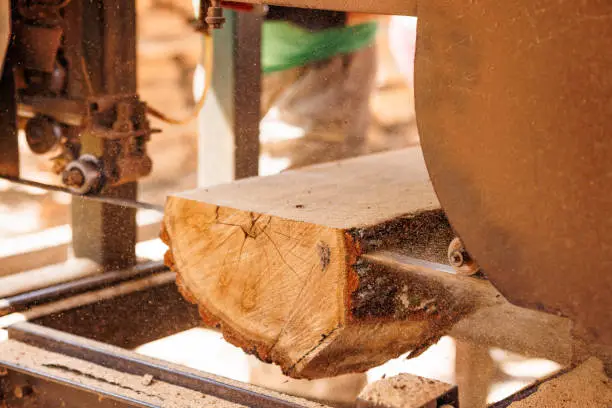Maintaining your sawmill properly is critical to ensuring its longevity, reducing unnecessary repairs, and achieving the best results in lumber production. This sawmill maintenance guide provides practical, detailed strategies for getting your sawmill in top condition this spring.
Why Sawmill Maintenance Is Crucial
A sawmill is a significant investment, and keeping it in excellent working condition ensures you get the best return. Regular sawmill maintenance improves its efficiency, prevents breakdowns, and reduces long-term repair costs. Additionally, well-maintained sawmills produce cleaner, more precise cuts, which ultimately improve the quality of your lumber output.
Imagine neglecting routine checks – small issues like blade misalignment or debris buildup can escalate into larger, more expensive problems. Think of maintenance as an investment in reliability and productivity.

Preparing Your Sawmill for Spring
Spring is a fresh start, and it’s the ideal time to prep your sawmill for the busy season ahead. Start by performing a detailed visual inspection. Look for cracks, wear, or loose components that may have developed during the winter months. If your sawmill was in storage, check for signs of rust or moisture damage, particularly on exposed metal parts.
Ensure that all safety systems, like emergency stops and protective guards, are functional. Consult your equipment’s manual for specific spring startup procedures—it often provides manufacturer-recommended steps to follow. Taking time to prepare now will minimize surprises once operations begin.
Essential Tools for Sawmill Maintenance
The right tools can make maintenance smoother and more efficient. For example, a socket wrench set is indispensable for tightening bolts, while a dial indicator is critical for ensuring blade alignment. Wire brushes and degreasers help with cleaning, particularly for removing stubborn dirt or sawdust from metal surfaces.
Additionally, consider investing in a digital tachometer to monitor engine speed, which can reveal hidden performance issues. By organizing a dedicated toolbox with these essentials, you’ll save time and frustration during routine checkups.

Cleaning Your Sawmill
Dust, grease, and wood debris are common byproducts of sawmill operation. While they may seem harmless, these residues can lead to friction, overheating, and wear if left unchecked. Start by using a high-powered air blower to remove loose debris from the machinery. Follow up with a degreaser to clean metal surfaces, focusing on areas like the blade housing and track system.
Once cleaned, inspect the equipment for any overlooked damage. Regular cleaning doesn’t just keep the equipment running smoothly—it also makes identifying potential problems easier.
Blade Inspection and Care
The sawmill blade does the heavy lifting, making its maintenance critical. Over time, blades can become dull or develop cracks. A dull blade doesn’t just reduce cutting efficiency; it also increases stress on the motor, leading to higher energy consumption and wear.
Inspect the blade regularly under good lighting. Check for visible signs of damage, such as chips or bends, and ensure the tension is correct. Keep a blade sharpener on hand for minor touch-ups and consider replacing the blade entirely if signs of wear are excessive. A sharp, properly tensioned blade ensures smoother cuts and longer sawmill life.
Lubrication Best Practices
Proper lubrication is the key to reducing wear and tear on moving parts. Neglecting this step can lead to overheating and mechanical failure. Focus on applying high-quality grease to bearings, chains, and pivot points. Additionally, consider using an anti-corrosion spray on exposed parts to protect against rust.
Be mindful of over-lubrication, as excess grease can attract dust and debris, creating abrasive deposits that counteract the benefits of lubrication. Check your lubrication schedule regularly and always use products recommended by the manufacturer.
Inspecting Belts and Bearings
Belts and bearings are essential for transmitting power and reducing friction in your sawmill. A worn-out belt can snap under stress, bringing your operation to a halt, while failing bearings can lead to inefficient power transfer.
During your inspection, look for fraying, cracking, or other signs of wear on belts. Bearings should rotate smoothly without wobbling. If you notice grinding noises or resistance, it’s time to replace them. Proactively addressing these issues can save you the hassle of dealing with sudden breakdowns.
Ensuring Accurate Calibration
Precise calibration ensures that every cut is consistent and minimizes material waste. Misalignment often results in uneven boards or inefficient operation. Use tools like a laser guide or dial indicator to check alignment and blade height. Adjust according to the manufacturer’s specifications to achieve the best results.
Taking the time to recalibrate after each maintenance session guarantees optimal performance. It’s a small step with big returns in terms of quality and efficiency.
Engine and Motor Maintenance
The engine or motor is the heart of your sawmill, so keeping it in peak condition is a priority. Regularly change the oil and replace filters to ensure smooth operation. Clean or replace spark plugs as needed, and inspect the fuel system for clogs or leaks.
If your sawmill uses an electric motor, check the wiring and connections to ensure they’re secure and free from corrosion. Consistent engine care reduces the likelihood of unexpected downtime and extends the life of your equipment.
Electrical System Inspection
Electrical systems are often overlooked but play a vital role in the overall functionality of your sawmill. Regularly inspect all wiring for frays, corrosion, or loose connections. Pay close attention to areas prone to vibration, as they’re more likely to experience wear.
Additionally, check the battery health if your sawmill has one. A multimeter can help you measure voltage and identify issues early. Cleaning terminals with a wire brush and applying a protective coating can prevent rust and ensure reliable operation.

Seasonal Maintenance Schedule
Developing a consistent maintenance schedule is key to long-term performance. Below is an example of a seasonal maintenance plan:
| Task | Frequency | Notes |
|---|---|---|
| Clean sawmill surfaces | Weekly | Remove debris and inspect for damage. |
| Inspect blades | Weekly | Check for sharpness, cracks, and tension. |
| Lubricate moving parts | Bi-weekly | Use high-quality grease and anti-corrosion spray. |
| Calibrate components | Monthly | Ensure alignment and blade height accuracy. |
| Engine check | Monthly | Inspect oil, filters, and fuel system. |
| Electrical system check | Quarterly | Examine wiring, connections, and batteries. |
Sticking to a regular schedule ensures smaller issues don’t develop into costly repairs.
Troubleshooting Common Issues
Even with consistent maintenance, issues can arise. Here are solutions for common problems:
- Blade Drift
- Cause: Misaligned blade or improper tension.
- Solution: Check blade alignment using a laser guide and adjust tension to the manufacturer’s specifications.
- Overheating
- Cause: Insufficient lubrication or clogged air vents.
- Solution: Apply lubricant to moving parts and clean the air intake regularly.
- Inconsistent Cuts
- Cause: Dull blades or miscalibration.
- Solution: Sharpen or replace the blade and recalibrate the cutting system.
- Engine Starting Issues
- Cause: Dead battery or clogged fuel lines.
- Solution: Test the battery with a multimeter and clean the fuel system thoroughly.
FAQs
1. How often should I inspect my sawmill blade?
Inspect your sawmill blade weekly for signs of wear, such as dull edges or cracks. Replace it immediately if you notice significant damage.
2. What’s the best way to prevent rust on my sawmill?
Apply an anti-corrosion spray to exposed metal parts and store your sawmill in a dry, covered area during periods of inactivity.
3. Can I use regular motor oil for my sawmill?
It’s best to use the oil recommended by your sawmill manufacturer. Regular motor oil may not meet the specific requirements of your equipment.
4. How do I know if my sawmill needs recalibration?
Signs of miscalibration include uneven cuts and blade drift. Use a laser guide to check alignment and recalibrate as needed.
5. What should I do if my sawmill won’t start?
Check the battery, fuel lines, and spark plugs. Cleaning or replacing these components often resolves the issue.
6. Are there any eco-friendly maintenance products available?
Yes, many manufacturers now offer biodegradable lubricants and cleaners that are effective and environmentally friendly.

Conclusion
Spring is the perfect time to give your sawmill the care and attention it needs. By following this comprehensive sawmill maintenance guide, you can ensure optimal performance, reduce the risk of breakdowns, and extend the life of your equipment. A well-maintained sawmill doesn’t just save money—it makes your work more enjoyable and efficient.

